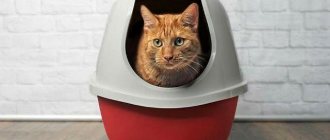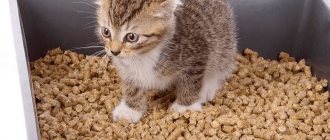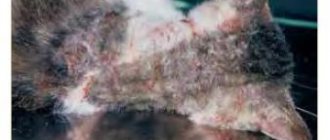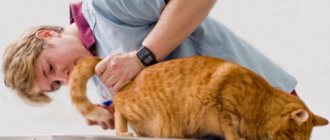Cats, like all domestic animals, can cause a lot of trouble for their owners. Naturally, an attentive and responsible owner is attentive to all changes, often visible to the naked eye, in his beloved cat. It is for this reason that if he noticed that the cat had a hard and swollen belly, he might be scared, and rightly so.
Before you contact your veterinarian, let's find out together what could be the causes of a hard belly in cats. Here's everything you need to know.
Organ enlargement
Various abdominal organs may increase in size, resulting in bloating.
Liver, spleen or kidneys
Enlargement of the liver, spleen or kidneys can occur as a result of a benign or malignant neoplasm. This can happen either as a result of tumors growing into the walls of organs, or as a result of solitary lesions, certain types of infections (especially fungal infections), accumulation of inflammatory cells, or a reaction to a disease in another part of the body.
Bladder
An enlarged bladder and difficulty urinating may be signs of a urinary tract blockage, a potentially life-threatening condition. It is more common in males, but can also occur in females.
Gastrointestinal tract
The gastrointestinal tract can be filled with gas, fluid, foreign material, and even food. This leads to bloating. The most dangerous of the above is blockage of the gastrointestinal tract by a foreign object.
Uterus
In unspayed cats, the uterus may become enlarged due to pregnancy or as a result of the accumulation of fluid or pus. The latter can be life-threatening.
After spay surgery, your cat may experience temporary bloating if she is overly active after surgery or if she has a reaction to the stitches. Therefore, it is important for your pet to rest while recovering from surgery. If the owner notices signs of inflammation, contact a veterinarian immediately.
Natural cause
A cat may have a tight belly for natural reasons. So, in late pregnancy, due to a serious enlargement of the uterus, tension in the peritoneal muscles occurs. This phenomenon is necessary to prevent injury to the kittens. In this case, the cat does not require treatment, since this condition is natural.
The abdominal wall becomes especially hard before lambing, since at this moment all the muscles begin to tense, preparing the body for the birth of kittens. After their birth, the abdomen may remain hard for several hours, thus causing muscle spasm, which is a consequence of severe overload.
Accumulation of fluid in the abdominal cavity
A bloated abdomen in a cat or kitten can be caused by the accumulation of moderate or large amounts of fluid in the abdominal cavity. Typically, in this case, the veterinarian may observe fluctuations when touching the area.
The accumulation of fluid in the abdominal cavity can be a consequence of many diseases:
- Hemorrhage: Bleeding into the abdomen can be caused by bleeding tumors, trauma to internal organs, low platelet counts, or platelet dysfunction. Another cause is poisoning from rat poison, which is called anticoagulant rodenticide.
- Cancer: A buildup of fluid and possibly blood in the abdomen can be caused by cancer.
- Heart Failure: Right-sided heart failure can lead to an inability to pump blood out effectively, resulting in fluid accumulation in the abdomen. Any concern about heart failure should be considered an emergency and require immediate diagnosis.
- Protein deficiency: Decreased protein production usually occurs due to liver failure or kidney or intestinal disease. When protein levels are too low, blood vessels in the body can begin to “leaky,” causing fluid to accumulate in the abdomen and other parts of the body.
- Inflammation: Fluid accumulation and inflammation in the abdominal cavity can be caused by, among other things, pancreatitis.
- Viral diseases: Feline infectious peritonitis, a viral disease in cats, usually results in abdominal fluid and bloating.
- Rupture of a hollow organ: A rupture of the bladder, gallbladder, or gastrointestinal organ can result in fluid from the organ in question leaking into the abdominal cavity and requires immediate veterinary attention. This pathology can occur against the background of conditions such as bladder stones and obstruction of the gallbladder or intestinal tract.
Bloating and gas formation: modern treatment options
Bloating is a very common and very unpleasant symptom that makes a person suffer even more than from abdominal pain. Bloating is a gas-related symptom. The sensation of excess gas in the gastrointestinal tract (GIT) is most often associated with increased tension in the wall of the hollow organ and can be a consequence of both actual excess formation (and/or impaired removal of gases from the GIT) and the result of high visceral sensitivity.
The subjective feeling of bloating (part of the symptom complex of flatulence syndrome) is usually accompanied by painful objective manifestations: an increase in abdominal circumference, loud rumbling (borborygms), sudden release of gases through the mouth (belching), accompanied by specific sound manifestations, uncontrolled release of foul-smelling gases (flatulence). All these symptoms cause psychological discomfort, feelings of shame and guilt, and negatively affect mental status, leading to restlessness, anxiety, depression, and phobic moods. If bloating and associated problems become persistent, a person’s normal lifestyle, family and social relationships are disrupted, the quality of life decreases, and the range of social and behavioral activity is narrowed. As a rule, gas-associated symptoms worsen during periods of psycho-emotional stress, with changes in climatic and time zones, and changes in nutritional patterns.
The symptom of bloating has no age limit [1] and is one of the most common, observed in more than 85% of gastroenterological patients [2]. Among patients with a functional gastrointestinal disorder (FGID), abdominal bloating is observed in approximately 24–97% of patients and, in addition, very often occurs in patients with gastroesophageal reflux disease (GERD), diseases of the pancreas and gallbladder, premenstrual syndrome, and impaired intestinal motility . Patients suffering from irritable bowel syndrome (IBS) with bloating are more likely to visit the doctor, and the impact of their disease on quality of life is more pronounced than the impact of IBS without bloating [3].
Abdominal bloating occasionally occurs in almost all people and, as a rule, is clearly related to dietary habits, i.e., consumption of foods with a high gas-forming potential. Thus, according to the results of a population study conducted in our country among a practically healthy contingent of respondents, it was found that over the last week signs of flatulence were noted by 28%, over the last month - 44%, over the last year - 62% of respondents [4].
The prevalence of functional bloating in adults in the United States ranges from 6% to 31%, with an average pooled prevalence estimate of 15.9%, and is more common in women (19.2%) than in men (10.5%) [5].
The high variability in the prevalence of bloating is associated, firstly, with different perceptions of the term. Patients and doctors interpret the content of this concept differently (as a variant of a subjective feeling of fullness and bloating of the abdomen; the appearance of hardness and tension in the anterior abdominal wall; excessive formation and discharge of gases; and as an objective increase in abdominal girth, and, finally, as a manifestation of any other dyspeptic complaints). Secondly, some patients suffering from bloating do not seek medical help for a long time, in particular, because of the moral and ethical complexes that accompany the excessive formation of gases in the intestines; on the contrary, other people ignore these symptoms, believing they are of little significance for overall health. All this not only complicates the epidemiological assessment of the syndrome, but also does not allow us to formulate diagnostic criteria convenient for clinical practice and objective assessment of the effectiveness of drug therapy.
In the new edition of the Rome IV criteria, functional abdominal bloating/distension still forms part of a large group of functional gastrointestinal disorders of the gastrointestinal tract-central nervous system interaction (Table 1) and is considered as a diagnosis per se in patients who do not meet the Rome criteria within the framework of other gastrointestinal tract disorders, although the possibility of mild abdominal pain and/or minimal bowel movements is acceptable.
Experts of the Rome IV criteria propose to combine functional abdominal bloating and distension into one concept, although they emphasize that these symptoms can be observed in isolation, do not correlate with each other and have different pathophysiological mechanisms of development [6].
Functional bloating differs from other cases of abdominal distension in its circadian rhythm: in typical cases it increases after meals (usually after eating certain so-called problem foods) and during the day and decreases or disappears at night. Problematic foods include sugars, more specifically oligo- and polysaccharides, which pass unchanged into the large intestine, where they are fermented by fermenting and proteolytic microorganisms. This process is accompanied by the release of gas. Excessive perception of intestinal gases forms the symptoms of the disease [7].
Key points in the conceptual understanding of the pathogenesis of functional abdominal bloating/distension include visceral hypersensitivity, gas formation in the colon, and changes in gastrointestinal motility. The mechanisms associated with visceral hypersensitivity are fueled by alert anticipation of perceived unpleasant events. In the dysregulation of the brain-gut axis, genetic predisposition, environmental factors, chronic stress, and disorders of the intestinal microflora play a role [8].
Currently, the main causes of functional bloating are considered: visceral hypersensitivity, colonic fermentation, excessive bacterial growth in the small intestine and changes in the metabolic potential of the colon microbiota, disruption of intestinal transit and rectal gas evacuation [9].
The study of the pathophysiological mechanisms of development of the symptom of functional abdominal distension, thanks to innovations in diagnostics, including abdominal induction plethysmography (which makes it possible to measure abdominal distension), allows us to consider an abnormal viscerosomatic reflex involving the diaphragm and muscles of the anterior abdominal wall as the main predictor of the formation of this symptom. The mechanism of this reflex is not yet known. Studies have shown that colonic fermentation, decreased rectal sensation, and impaired intestinal transit may contribute to abdominal distension in some patients [9, 10].
The diagnosis of functional swelling must be established with indispensable reliance on 3 key positions: 1) anamnesis and clinical picture; 2) a thorough physical examination; 3) exclusion of anxiety symptoms with the minimum required set of laboratory and instrumental tests [11].
Despite the significant prevalence of functional bloating/distension of the abdomen, there are no clearly developed treatment algorithms for this pathology. The list of methods for effective treatment of bloating and distension is very limited (Table 2).
Some dietary changes, such as avoiding carbonated drinks and foods that tend to cause gas, can help reduce the symptoms associated with bloating. The exclusion from the diet of poorly digestible and assimilated short-chain carbohydrates (fermentable carbohydrates; oligo-, di- and monosaccharides; polyols) also has a positive effect, that is, bloating decreases when following a diet that excludes the entry into the colon of intensively fermentable substrates, such as wheat products; fruits rich in fructose (for example, apples, pears); vegetables containing fructans (onions, asparagus, etc.); products containing raffinose (for example, legumes, beets), sorbitol (sugar-free chewing gum) [3].
Helps prevent bloating caused by eating problematic foods by taking alpha-galactosidase (Orlix, dietary supplement) with meals. Alpha-galactosidase provides enzymatic activity missing in the human body, breaking down oligosaccharides into simpler, easily digestible forms. As a result of the use of Orlix, the amount of fermentable substrates entering the colon is reduced and the overproduction of gas associated with nutrition is prevented [12, 13].
In addition, some improvement can be expected from moderate physical activity, which facilitates bowel movements and gas transport.
Reduces the severity of bloating and abdominal distension by taking prokinetics. Prokinetics, accelerating intestinal transit, promote the movement of gas through the intestine and its removal to the outside [14]. However, prokinetics (lubiprostone and linaclotide), recommended by experts of the Rome IV criteria, for the treatment of bloating are not registered in our country. Among the drugs available on the Russian pharmaceutical market, trimebutine (Trimedat) is a universal regulator of gastrointestinal motility. Trimebutine is an opiate receptor agonist, its modulating effect on gastrointestinal motility and analgesic effect are associated with a nonspecific effect on all classes of peripheral opiate receptors: μ, κ and δ. Trimebutine stimulates the evacuation function of the stomach, normalizes intestinal motility and gas transit, reduces visceral sensitivity, helps relieve the feeling of bloating and discomfort, and has a beneficial effect in both hypokinetic and hyperkinetic forms of disorders of motor activity of the gastrointestinal tract. In the treatment of flatulence, a course prescription of the drug Trimedat 200 mg three times a day 30 minutes before meals for 30 days or more is indicated [15].
Currently, the study of the role of disturbances in the intestinal bacterial flora in the occurrence of gastrointestinal tract is ongoing. Thus, it was found that there are some species differences in the microbiome of healthy people and patients with bloating. This has prompted numerous clinical studies to study the effectiveness of antibiotics, probiotics and prebiotics for flatulence. Two probiotics have been shown to reduce visceral sensitivity in animal models: Bifidobacterium infantis and Lactobacterium acidophilus.
In the treatment of disorders associated with high levels of gas in the gastrointestinal tract, antiflatulents, or defoamers, are traditionally used. A drug that reduces foaming in the intestinal lumen is simethicone, which is a high-molecular silicon-based polymer - dimethylsiloxane with the addition of silicon dioxide. According to its mechanism of action, simethicone is a surfactant that reduces the surface tension of gas bubbles in chyme and mucus in the intestinal lumen, leading to their rupture. In this case, a process of coalescence occurs - the fusion of gas bubbles and the destruction of foam, as a result of which free gas is able to be absorbed through the intestinal mucosa or evacuated along with the intestinal contents. The dose is selected individually depending on the severity of symptoms. The main use of defoamers in clinical practice is the symptomatic treatment of various gastrointestinal diseases accompanied by excessive gas formation [2].
It is known that antidepressants modulate visceral sensitivity, they are often recommended for patients with gastrointestinal tract, but to date, based on the results of clinical studies, impressions of their effectiveness have not been definitively determined [3].
As a result, we have to admit that bloating and distension of the abdomen are difficult to treat. As soon as the connection of these symptoms with organic diseases is excluded, it is reasonable to place emphasis on the functional nature of these conditions, and in treatment it is advisable to pay attention primarily to the implementation of a diet and taking the biologically active food supplement Orlix.
The active component of Orlix is a natural enzyme - alpha-galactosidase (producer - the bacterium Aspergillus niger). 1 tablet contains 5 mg (corresponds to 150 units) of alpha-galactosidase. Does not contain GMOs, lactose, milk proteins, dyes, flavors and preservatives.
In order to study the effectiveness and tolerability of Orlix in patients with functional bloating/distension of the abdomen, an open, non-randomized, placebo-uncontrolled, multicenter study was conducted in Moscow city clinics.
Objectives of the clinical trial:
- To study the possibility of correction of gas-associated symptoms after ingestion of problematic foods in patients with functional bloating/distension of the abdomen when consuming Orlix with meals.
- Assessment of the tolerability of Orlix and its impact on quality of life.
Problematic foods:
- all types of beans (white, red, brown and their variants);
- lentils - all types;
- all types of cabbage (white, red);
- kohlrabi and Brussels sprouts;
- cauliflower and broccoli;
- salads of all kinds;
- onion garlic;
- carrots, parsley;
- flour and flour products (especially from wholemeal flour);
- pistachios and sesame;
- soybeans and soy products (soy milk, tofu).
Study design
The study involved 55 patients with complaints of flatulence (bloating, belching, increased passage of gas, a feeling of fullness in the abdomen, increased abdominal circumference) associated exclusively with the consumption of problematic foods, after excluding all other possible causes of gas-associated symptoms. Patients were examined according to a unified plan (general clinical analysis of blood, urine, stool, biochemical blood test, esogastroduodenoscopy, colonofibroscopy, ultrasound examination of the abdominal organs). At the end of the study, all patients underwent a repeat examination of general clinical and biochemical blood tests.
The average duration of complaints in patients included in the study was 3.5 years. The male to female ratio is 20:35. Average age 38 ± 5.5 years.
A prerequisite for patient inclusion in the study was the refusal to use any antiflatulent drugs and the continuation of taking problematic (gas-forming) products in the usual volume.
All patients included in the study took the dietary supplement Orlix with the first portion of problem food in a dose of 2–4 tablets for 2 months.
The effectiveness of Orlix was assessed based on the patient’s subjective assessment of the manifestations of flatulence at the beginning of the study, and then during the 1st and 2nd control studies (after one and two months of treatment, respectively) according to the severity of symptoms: 1st degree - all gases associated symptoms are completely eliminated, 2nd degree - mild symptoms of flatulence that do not bother the patient in everyday life, 3rd degree - improvement is observed, but in a mild form gas-associated symptoms persist, 4th degree - very little or no improvement.
As part of the overall assessment of the effectiveness of Orlix after 2 months of its use, based on a subjective assessment of the severity of symptoms of flatulence, patients were divided into 4 groups: 1st group - excellent - improvement of symptoms by 100% (corresponding to the assessment of the 1st degree), Group 2 - very good - improvement of symptoms by 50-80% (corresponding to a grade 2 assessment), Group 3 - moderate - improvement of symptoms by 30-50% (corresponding to a grade 3 assessment), 4th group - no changes - 0–30% (corresponds to a grade 4 assessment). All study statistics are based on patients' subjective assessment of gas-related symptoms after consuming problematic foods.
The effectiveness and safety of Orlix was also analyzed based on data from the SF-36 questionnaire to assess quality of life.
A study of anthropometric parameters (body weight and abdominal circumference) was carried out before the start of treatment and upon its completion.
Research results
Subjectively, already at the first control examination, 28 (50.9%) patients noted a complete elimination of the development of symptoms of flatulence after eating problematic foods while taking Orlix with meals; after 2 months of treatment, the number of patients with excellent effectiveness of Orlix increased to 32 (58.2 %).
Mild symptoms of flatulence persisted and did not bother the patient in everyday life in 19 (34.6%) patients at the end of the first month of treatment; subsequently, two of them noted the almost complete disappearance of gas-associated symptoms (with an increase in the single dose of Orlix to 3 tablets).
It is noteworthy that the number of patients who reported that, despite taking Orlix, they still had mild gas-associated symptoms, did not depend on the duration of treatment: 6 (10.9%) people at the 1st control and 5 ( 9.1%) at the end of observation. In one patient from this group, complete relief of abdominal bloating occurred when the single dose of Orlix was increased to 3 tablets.
Only 2 (3.6%) patients noted no improvement during the first month of treatment. One patient had the Orlix dose increased to 3 tablets per dose when consuming problematic foods, and against this background he noted a significant improvement. In another patient, increasing the dose of Orlix to 4 tablets per dose resulted in only minor relief of symptoms.
Thus, subjective improvement, despite continuing to take the usual amounts of problem foods, when using Orlix with meals was detected in 98.2% of patients (Table 3), and all of them noted the rapid onset of action of the biologically active food supplement when following the regimen taking Orlix with the first portions of food.
The overall assessment of the effect of Orlix after 2 months of its use, based on the patient’s subjective assessment of the severity of symptoms of flatulence, is presented in table. 4. An excellent effect was registered in 32 (58.2%) patients, a very good effect in 17 (30.9%), moderate improvement in symptoms was noted by 5 (9.1%) people. Only one patient in the study reported very little improvement in flatulence symptoms.
At the same time, not only subjective improvement was noted in patients; when studying the dynamics of anthropometric parameters, a tendency to a decrease in abdominal circumference was revealed, which was more pronounced in women while maintaining a constant body weight (Table 5).
When analyzing changes in the quality of life according to the nosologically nonspecific questionnaire SF-36 during treatment with Orlix, positive dynamics were also revealed: there was a significant improvement in the quality of life in almost all indicators of both physical and mental functioning. The mean physical functioning (PF) score increased from 85.1 ± 6.4 to 92.2 ± 2.1 points (p < 0.05); role physical functioning (RP) - from 51.3 ± 5.1 to 85.2 ± 2.3 points (p < 0.05); the general health (GH) score increased from 48.9 ± 8.4 to 61.21 ± 2.1 points (p < 0.05). Indicators of the psychological component of health changed as follows: vitality (VT): 54.6 ± 6.3 and 78.2 ± 4.9 points (p < 0.05); social functioning (SF) - 47.6 ± 11.2 and 68.8 ± 5.3 points (p < 0.05); role emotional functioning (RE) - 58.8 ± 8.4 and 70.2 ± 3.1 points (p < 0.05).
As part of the subjective assessment, the dosage of Orlix was statistically evaluated. At the beginning of the clinical study, a dosage of 2 tablets was prescribed to 32 (58.2%) patients, 3 tablets to 23 (41.8%) patients, a dosage of 4 tablets was not prescribed. During the first control, in 6 patients with the 3rd degree of severity of gas-associated symptoms, the dosage of Orlix was increased to 3 tablets and in 1 patient who did not notice an improvement in symptoms, the dose of the drug was increased to 4 tablets. However, increasing the dosage did not significantly affect the subjective feeling of the severity of flatulence symptoms. Thus, it was found that the dosage of Orlix is less correlated with the severity of gas-associated symptoms, and more dependent on the amount of food eaten; usually it is enough to take 2-3 tablets during a normal lunch (Table 6).
The dynamics of the main parameters of general clinical and biochemical blood tests (ALT, bilirubin, glucose) in the direction of deterioration were not observed (Table 7).
All patients noted good tolerability while taking Orlix; no adverse reactions were recorded.
Discussion
The study included patients with functional bloating/distension. All of them noted the connection between the occurrence of gas-associated symptoms and the consumption of problematic foods, such as beans, lentils, all types of cabbage, as well as kohlrabi, broccoli, salads of all types, onions, garlic, carrots, parsley, whole wheat flour products, pistachios and sesame seeds, soybeans and soy products. These products are united by a high content of oligosaccharides (melibiose, raffinose, stachyose, verbascose), formed by galactose and fructose, in various ratios (Table 8), since soy contains a lot of them, they are also called “soy oligosaccharides”.
Galactose (from the Greek root γaλακτ-, “milk”) is one of the simple sugars, a monosaccharide from the hexose group. D-galactose is widespread in nature, it is part of oligosaccharides (melibiose, raffinose, stachyose), some glycosides, plant and bacterial polysaccharides (gums, mucus, galactans, pectins, hemicelluloses), in animals and humans - in the composition of lactose, group-specific polysaccharides, cerebrosides, keratosulfate, etc. Fructose (fruit sugar), C6H12O6 - monosaccharide, isomer of glucose. In its free form, fructose is present in almost all sweet fruits, and also makes up up to 80% of honey; as a monosaccharide unit it is part of sucrose and lactulose.
Soy oligosaccharides are widely used in the food industry (soft drinks, candies, cakes, industrially prepared wheat products, dairy products, infant milk powder, etc.), and are included in many pharmaceuticals.
But human digestive enzymes are not able to break down the chemical bond between two galactose molecules, so these oligosucroses are not absorbed in the small intestine, but are hydrolyzed by enzymes of colon microbes (which have a set of enzymes that utilize soy sugars) with the formation of organic acids and large amounts of gases: H2, CH4 , CO2 (hence the name of products containing such oligosaccharides - gas-forming, or problematic).
As a result of research, it was possible to isolate a unique bacterial enzyme - α-galactosidase, which hydrolyzes galactosidase compounds, breaking down oligosaccharides into simple carbohydrates without the formation of gases. Such enzymes are found in the bacteria Bacteroides fragilis, Bacteroides thetaiotaomicron and Streptomyces avermitilis.
Alpha-galactosidases (syn. melibiases) have “exoactivity”, i.e. they cleave off the terminal non-reducing residues of alpha-D-galactose from the oligosaccharide molecule, hydrolyzing complex sugars to monosaccharides: glucose and galactose, which are absorbed by the cells of the intestinal mucosa and are used in body as a source of energy.
The use of the enzyme alpha-galactosidase in nutrition provides enzymatic activity absent in the human body, limiting the entry of oligosaccharides into the large intestine in an undigested form, where they undergo anaerobic bacterial hydrolysis with the formation of gases.
When adding this enzyme in the form of a dietary supplement to Orlix food, we found its effect in a group of 55 people to be excellent in 58.2%, and very good in 30.9%. Thus, patient-reported improvement after taking Orlix occurred in the vast majority of patients (89.1%).
When analyzing changes in quality of life according to the SF-36 questionnaire during monotherapy with Orlix, a significant improvement in quality of life was revealed in terms of both physical and psychological functioning.
All patients while taking Orlix noted that it was well tolerated.
Conclusion
In patients with functional bloating, taking the dietary supplement Orlix (active substance alpha-galactosidase) provides high effectiveness in relieving gas-associated symptoms and improves quality of life. Recommended dosage of Orlix: 2-3 tablets with meals with the first portions of food when consuming gas-forming foods. It is important to note that the onset of action of Orlix is immediate; flatulence does not occur when eating problematic foods. The dosage depends on the volume of problem foods eaten; 2-3 tablets are usually sufficient for average amounts of food. In the future, the patient can determine the optimal dose for himself.
Orlix is safe to use and can be recommended for healthy people who consume gas-producing products.
Reducing gas production in the intestines may represent an effective therapeutic strategy to prevent the development and/or exacerbation of gas-related symptoms in any gastrointestinal disease (functional or organic) when their cause is at least in part due to hyperproduction of gas.
Literature
- Belmer S.V., Gasilina T.V., Khavkin A.I. et al. Functional disorders of the digestive organs in children. M.: RGMU, 2005. 36 p.
- Butorova L.I., Kolomoets A.N., Tarasova E.S. Excessive gas formation syndrome in the intestines: clinical significance and principles of therapy // Difficult Patient. 2005.
- Functional disorders of the gastrointestinal tract. A practical approach based on clinical experience / Ed. B. E. Lacey, M. D. Crowell, D. C. DiBaiza. Per. from English edited by S. V. Demicheva. M.: GEOTAR-Media, 2022. 352 p.
- Flatulence syndrome in therapeutic practice: optimization of treatment approaches: educational manual / Ed. Yu. P. Uspensky. St. Petersburg: InformMed, 2010. 63 p.
- Sandler RS, Stewart WF, Liberman JN, Ricci JA, Zorich NL Abdominal pain, bloating, and diarrhea in the United States: prevalence and impact // Dig DisSci. 2000; 45:1166–1171.
- Drossman DA Functional gastrointestinal disorders: history, pathophysiology, clinical features and Rome IV // Gastroenterology. 2016; 150: 1262–1279.
- Agrawal A., Houghton LA, Lea R. et al. Bloating and distension in irritable bowel syndrome: The role of visceral sensation // Gastroenterology. 2008. Vol. 134. P. 1882–1889.
- Camilleri M., Lasch K., Zhou W. Irritable bowel syndrome: Methods, mechanisms, and pathophysiology. The confluence of increased permeability, inflammation, and pain in irritable bowel syndrome // Am J Physiol. Gastrointest. Liver Physiol. 2012, 303: 775–785.
- Lewis MJ, Reilly B, Houghton LA et al. Ambulatory abdominal inductance plethysmography: towards objective assessment of abdominal distension in irritable bowel syndrome // Gut. 2001; 48: 216–220.
- Houghton LA, Lea R, Agrawal A et al. Relationship of abdominal bloating to distention in irritable bowel syndrome and effect of bowel habit // Gastroenterology. 2006; 131:1003–1010.
- Pimanov S.I., Silivonchik N.N. Rome IV recommendations for the diagnosis and treatment of functional gastroenterological disorders. A manual for doctors. M., 2016. 160 p.
- Orlix®. Instructions for use.
- Expert opinion of the Federal Budgetary Institution of Health and Safety of Rospotrebnadzor No. 10–2 FC/2098 dated May 28, 2015.
- Cadarella M., Serra J., Azpinoz F. et al. Prokinetic effect in patients with intestinal gas retention // Gastroenterology. 2002. Vol. 122. P. 1748–1755.
- Ivashkin V. T., Poluektova E. A., Reykhat D. V. et al. Efficacy of the most commonly prescribed groups of drugs in patients with functional disorders of the gastrointestinal tract - functional dyspepsia syndrome and irritable bowel syndrome (Results of an observational study) // Ross. Journal of gastroenterology, hepatology, coloproctology. 2016; 26 (4): 15–23.
- Posserud I., Stotser PO, Bjornsson ES et al. Small intestinal bacterial overgrowth in patients with IBS // Gut. 2007. Vol. 56. P. 802–808.
L. I. Butorova*, 1, Candidate of Medical Sciences N. G. Kadnikova** M. A. Osadchuk*, Doctor of Medical Sciences, Professor T. E. Plavnik*** G. M. Tokmulina*, Candidate of Medical Sciences
* Federal State Autonomous Educational Institution of Higher Education First Moscow State Medical University named after. I. M. Sechenova Ministry of Health of the Russian Federation, Moscow ** TsKBVL FMBA “Goluboe”, Goluboe *** State Budgetary Institution of Public Health No. 195 DZM, Moscow
1 Contact information
Bloating and gas formation: modern treatment options / L. I. Butorova, N. G. Kadnikova, M. A. Osadchuk, T. E. Plavnik, G. M. Tokmulina
For citation: Attending physician No. 2/2018; Page numbers in the issue: 61-66 Tags: excess gas formation, enzymatic preparation
Intestinal parasites
Causes of bloating in cats may include gastrointestinal parasites, notes the Cornell Feline Health Center. This is more common in kittens, as they are more likely to become infected with worms. Your veterinarian can identify intestinal parasites by testing your cat's stool. Treatment usually involves taking oral antiparasitic medications.
What to do if your kitten has a big belly
What to do if your kitten’s tummy suddenly becomes bloated? First you should observe your pet: how is he feeling? You should be alert to symptoms such as:
Photo: ginger kitten sitting on a tray | Dreamstime.com
- Diarrhea or constipation. Unusual color and smell of feces;
- Pain when trying to go to the toilet;
- Vomit;
- Refusal to feed or excessive overeating, thirst;
- Increased body temperature.
Let us immediately note that if a kitten has bloating due to ascites, peritonitis, pancreatitis, liver problems, hormonal disorders or oncology, then only a specialist can help. And even then, if you bring a sick baby to the clinic on time. In other cases, you can do this:
- If the kitten has a hard belly and has not had stool for more than 2-3 days, then the problem is most likely constipation.
At home, you can get rid of the problem using Vaseline oil (0.1 ml of oil per 100 g of kitten weight three times a day). The drug Duphalac gives a good effect (0.5 ml per 1 kg of body weight 1-2 times a day until bowel movements are established), but before use it is better to consult a specialist. Perhaps the veterinarian will also recommend using Microlax microenemas at home, and in some situations, cleansing enemas and droppers will need to be done in a hospital; - They fight worms with the help of anthelmintics
(for example, Dirofen paste for kittens is administered in an amount of 1 ml per 1 kg of weight; drops from a 0.25 ml pipette of Stronghold are applied to the withers). Only when using anthelmintic drugs should you take into account that not all of them can be used for kittens under the age of 2-3 months; - The problem of overeating and proper diet is not difficult to solve.
Dry or canned super-premium baby food is the best choice for kittens. The packaging of such products indicates the recommended serving and number of feedings per day. In addition, it is important to ensure that the kitten drinks enough and exercises actively so that there are no problems with excess weight and bowel movements.
Abdominal masses
Why does my cat have a bloated belly? Perhaps your pet has a tumor in one of the abdominal organs. Such pathologies are more common in adult cats. A neoplasm in the abdominal cavity can be benign or malignant. To make an accurate diagnosis, a comprehensive examination is necessary.
Depending on the location and type of tumor, treatment may include surgery to remove the tumor, chemotherapy, or observation and supportive care with medications.
Breed characteristics
Some breeds have a fold in the abdominal area their entire life. And, by the way, there is nothing reprehensible in this, since natural affiliation simply obliges you to “possess” a fat tail.
Do not be upset if the skin hangs on the belly of a cat of the following breeds: Canadian Sphynx, Pixie-Bob, Bengal, Scottish Straight, Scottish Shorthair. The reasons for the presence of loose skin in pets of these breeds are unknown. Probably, the fat layer should protect short-haired and hairless individuals from the cold, and for others, the fat tail should protect the abdominal organs from injury during fights.
Important! You should not try to reduce a saggy belly by starving your pet. With such a diet, the skin will not go anywhere, but, on the contrary, will become even more noticeable on a body that is too thin
In those cats that, by their breed vocation, are forced to “wear” a fat tail, the stomach decreases during the lactation period. As soon as the feeding of the kittens stops, the size of the saggy tummy returns to normal.
Feeding cheap foods
Veterinarians strongly recommend analyzing your pet’s diet. After all, unhealthy food from economy class (Whiskas, Felix, Kitekat) will sooner or later cause disruption of the digestive tract. Along with the indicated nutrition, the foods that people love to feast on are harmful. Sausages, dairy products, soups and main courses from the human table are not suitable for consumption by animals. Pathologies of the gastrointestinal tract can easily lead to the death of a cat. High-quality industrial food that will not harm your pet - Akana, Hills, Perfect Fit, Purina Van and other branded products from the premium, superpremium segment. If the owner’s choice is made in favor of natural nutrition, then among the healthy foods for the mustachioed pet can be noted: cereals (rice and oatmeal), meat (beef, turkey, rabbit), stewed vegetables (carrots, cabbage, beets). It is necessary to remember the basic rule: mixing natural food and ready-made food is prohibited.
If your cat has sagging skin on its belly despite a well-thought-out diet, then you should slightly reconsider its diet.
It is important to reduce the calorie content of dishes by reducing the amount of meat component to 50-70%
Diagnosis of bloating in a cat
If your cat has a hard, distended abdomen, an examination and diagnostic testing should be performed to determine the cause. Typical types of diagnostic testing for bloating include a complete blood count, urinalysis, ultrasound and/or x-ray of the abdomen, chest x-ray, fluid testing, and biopsy (in the case of a mass). Sometimes more special diagnostics are required if an infectious disease is suspected or an assessment of the condition of specific organs. The examination recommended by your veterinarian will depend on the individual case.
When a saggy belly is normal
So, it was already mentioned above that some cats have a pouch hanging in their lower abdomen for completely harmless reasons:
- Multiple births or large births
- if the mother cat has a lot of babies (some mustachioed pets give birth to 8-12 kittens) or if they are very large, then the uterus is greatly distended, and with it the peritoneal walls. By the way, after childbirth, the belly often hangs in miniature females who had only a few medium-sized kittens in the litter; - Old age
- whatever one may say, but by old age in almost all pets the skin becomes flabby and the abdominal tissues become weak. Does an elderly cat or cat have a hanging belly, although this has not been observed before? Perhaps it’s all to do with the pet’s advanced years; - Breed predisposition
- if a Canadian Sphynx, Pixie Bob, Bengal or British cat has a hanging belly, then there should be no cause for concern. For such breeds, a fat fold on the belly is considered normal; - Constipation
- the inability to have normal bowel movements can hardly be called normal, but quite healthy cats often suffer from problems with bowel movements, for example, due to improper feeding of the pet, low fluid intake, or after taking certain medications. With constipation, the cat's belly is swollen and enlarged, and it seems as if it is sagging.
Bloating in a cat: treatment
Treatment for bloating in a cat or kitten depends on the underlying pathology and may include, but is not limited to, removing abdominal fluid, medication, and/or surgery. In any case, it is important to monitor the pet’s condition and consult a veterinarian. Any physical or behavioral changes must be monitored. If an owner is concerned that their cat's belly looks bloated, the easiest thing to do is call a veterinarian and get their expert opinion on what to do next.
Treatment
Treatment can be conservative or surgical. This will depend on the cause of the hard belly syndrome. For example, in case of helminthic infestation, it will be necessary to carry out specific antiparasitic therapy; in case of constipation, a special diet and mild laxatives will be required. Antispasmodics are often recommended as symptomatic therapy. These remedies help relax the muscles of the abdominal wall, but can neutralize many symptoms and complicate diagnosis. Therefore, it is better for the veterinarian to show the animal before trying to help it. The most competent method of first aid would be to provide the animal with rest and deliver it to a veterinary hospital.
Bloating in a cat: treatment
Stomach upset in a cat: what to do and how to treat it
Liver diseases in cats and their treatment with dietary cat food
Is your cat gaining weight?
Recovery of a cat after illness or surgery
Signs of pathology
A cat's enlarged belly should be the reason for an unscheduled visit to the veterinarian. Sometimes, if the outflow of urine is disrupted or the intestines are blocked, a timely operation can save the life of a pet.
Why do certain pathologies develop if, in the opinion of the owners, the animal is well cared for? The causes of the development of diseases accompanied by enlargement of the peritoneum are:
- poor nutrition, lack of animal access to water;
- non-compliance with the schedule of vaccination and anthelmintic measures;
- peritoneal injuries;
- development of chronic diseases of internal organs.
There are a number of symptoms, the occurrence of which requires urgent consultation with a veterinarian. These include:
- diarrhea;
- vomit;
- apathy;
- increase in body temperature (hot, dry nose and ears);
- lack of appetite;
- the presence of blood, parasites and their eggs in the stool or urine.










